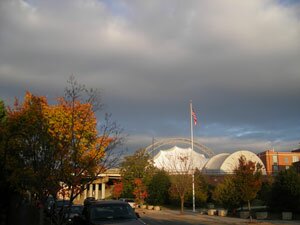ONARCHITECTURE- Pavilion projections: An art work waiting to happen?

Is the Pavilion a blank canvas waiting for an artist? Several local architects and planners think so.
PHOTO BY HAWES SPENCER
The new Downtown Pavilion has been called many things– a Lobster Trap, a Giant Clam, an Evil Frog, and a Sail Without a Ship, to name just a few. Its blank white expanse seems to be calling out to be named, to be painted on, sitting as it does like a year-round wedding tent at the east end of the Mall.
Could the Pavilion be an unfinished work of art? Is it a canvas waiting for an artist?
"The amphitheater canopy as a blank canvas?" ponders Maurice Cox, an urban planner, architect, and former mayor. "The canopy looks like a blank canvas if ever I've seen one."
"I couldn't agree more," says UVA architectural historian Richard Wilson. "It would be a nice idea to have some sort of competition for a painted top or an appliqué. I can think of a couple more things that could stand this, such as the coal towers at UVA near the railroad bridge."
"Interesting observation," says architect Gary Okerlund. "I agree it's very large and has quite a visual presence. However, I think the white tends to blend with the sky, more often than not, and that minimizes its presence. Its simple but elegant form seems to help bridge its scale."
Okerlund worries that any adornment to the structure might call more attention to it, increasing its already ponderous scale.
"The skeptic in me also thinks the possibility of getting a design that would merit the dramatic new self-image is slim," says Okerlund. "I would also be concerned about a painted surface working over the membrane."
Still, Okerlund suggests that when the canvas of the Pavilion needs replacing, something more dynamic might be considered. He uses an open market structure in Santa Caterina in Barcelona as an example. "Not because it's necessarily a useful example," he says, "but because it expresses the creativity and élan one could hope for here."
Indeed, the pavilion market in Barcelona features exciting colored tiles and patterns that blend with its urban environment, but it's strikingly modern. If not an inspiration for a second incarnation of the Pavilion, Okerlund suggests the Spanish version could serve as a "quality-level" model for fitting the City Market into development plans for Water Street.
"It's an interesting idea," says BAR vice chair Syd Knight, "but there are lots of pitfalls."
Knight recalls that decorating the Pavilion was never discussed because the original intent was that the canopy would come down in the winter months and there would be gardens or designed landscaping beneath it.
"I believe they found it was too expensive to keep taking that thing down," he says.
Knight doesn't dismiss the idea of decorating the Pavilion canvas, but he thinks it would have to be done "very, very well."
"I've seen trompe l'oeil done beautifully," he says, "if you find someone who knows what they're doing. But if it's done badly on a structure that size, it would be hideous."
When it was proposed in 2004, the Board of Architectural Review chair called the Pavilion "too large for the site." But Knight points out that people are starting to get used to the Pavilion, and that major changes now might rekindle the controversy surrounding its arrival. He also foresees a grueling design review process with such a project. Practically, he wonders if the surface could even hold paint or whether such a procedure might void its warranty.
"If someone had a great idea, a great design, it might work," Knight says. "But it would be hard."
"Early on, yes, it was discussed," says Pavilion manager Kirby Hutto about decorating or painting the big white tent. "But it's not an option."
As Hutto points out, the high-tech impregnated vinyl is coated to protect against UV rays and water.
"Something like that would compromise the integrity of the fabric," he says. "Besides, the fabric would not take paint."
Even if it could be painted, says Hutto, he groans when considering how difficult it would be for such a project to pass BAR review.
"We've experimented with lights, projected images," he says. "And we may try to project images on the canvas at next year's Festival of the Photo."
For Cox, lighting projections might be the way to go.
"I've seen a number of incredible lighting projections by media artists like Jenny Holzer," he says, "who have been commissioned to project art on buildings."
While he was living in Florence, Cox says, the city commissioned a series of lighting projections for the famous incomplete facade of the Renaissance church Santa Spirito.
"In other words, a series of light projections on the amphitheater canvas could be awesome," he says. "If you think about it, the structure to mount the lights is already there– the arched truss."
Cox admits it might be costly, but suggests a non-profit such as the University of Virginia Art Museum could partner with the Thomas Jefferson Center's community chalkboard and the UVA School of Architecture and apply for a National Endowment for the Arts grant for a project like this.
"The lighting projections wouldn't have to be word-based, but they would have to be sophisticated, provocative, and spectacular," says Cox. "Given all the artists we have in this community, I can't imagine that it would be otherwise."
#